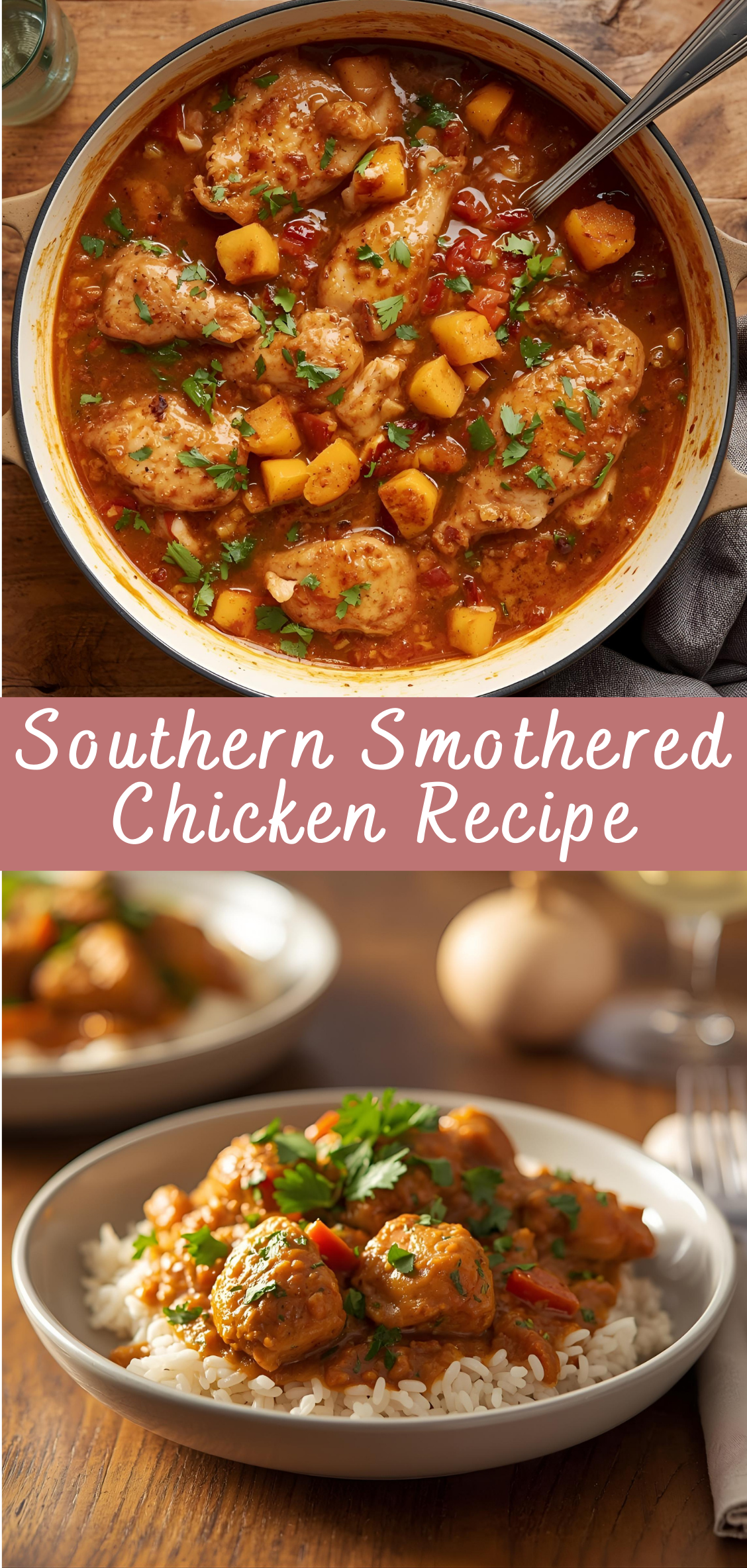Southern Smothered Chicken—A Legacy of Love, Flavor, and Soul
In the heart of Southern cooking lies a deep and enduring respect for food that comforts, nourishes, and tells a story. It’s a cuisine shaped by resourcefulness, history, and an unshakable commitment to turning simple ingredients into something memorable. Few dishes embody this spirit more fully than Southern Smothered Chicken—a slow-simmered, gravy-drenched comfort food classic that carries the warmth of generations in every tender bite.

To smother a dish, in the Southern culinary lexicon, is not merely to cover it. It is to envelop it—to embrace it in rich, savory gravy that seeps into every corner of the plate. It is to slow down the cooking process, to coax out flavor, and to turn humble cuts of meat into something that tastes like home. Smothered chicken is the kind of meal that doesn’t just feed the body—it soothes the soul.
This dish isn’t flashy. It doesn’t rely on expensive ingredients, trendy techniques, or modern reinvention. Its beauty lies in its simplicity and depth of flavor. Bone-in, skin-on chicken pieces are seared to golden perfection, then simmered gently in a deeply seasoned onion gravy until the meat is so tender it nearly falls off the bone. Each element serves a purpose. The browning adds richness. The flour thickens and binds. The onions—always onions—are not just a flavoring agent but a key ingredient, caramelizing slowly until they lend their natural sweetness to the dish.
Southern Smothered Chicken is a recipe born from African American culinary traditions, deeply rooted in the American South. It carries echoes of West African techniques and flavors, adapted over centuries to the ingredients and tools that enslaved cooks had available in plantation kitchens. These cooks—often the unsung architects of what we now call Southern cuisine—turned cuts like chicken thighs and drumsticks, ingredients once considered lesser, into dishes worthy of celebration. Through trial, instinct, and care, they created recipes that transcended time and circumstance.
Today, smothered chicken is a staple on many Southern tables. It might be served on Sundays after church, or on a weeknight when comfort is needed more than convenience. It’s the centerpiece of family reunions, a must-have in soul food restaurants, and a beloved memory on the plates of those who grew up in kitchens filled with the scent of sizzling chicken and simmering gravy.
There is no single “correct” way to make it. Like gumbo or collard greens, every family has its version, its secrets, its methods passed down through storytelling rather than strict instruction. Some add bell peppers or garlic. Some use milk or cream in their gravy. Some serve it over rice, others with mashed potatoes or cornbread. But the heart of the dish—the chicken, the smothering, the soul—remains the same.
This guide will walk you through a deeply flavorful, traditional approach to Southern Smothered Chicken, while offering variations, techniques, and stories along the way. We’ll discuss not just the “how,” but the “why”—why certain ingredients matter, why low and slow wins the race, why this dish has endured and evolved, and why, despite all the culinary trends that come and go, it remains a cornerstone of true Southern hospitality.
Prepare yourself for more than a recipe. This is a journey into the heart of a dish that connects people to place, history, and memory. Whether you’re cooking it for the first time or returning to it like an old friend, Southern Smothered Chicken is a dish that always welcomes you home.
Detailed Instructions for Southern Smothered Chicken
At its core, Southern Smothered Chicken is about taking your time. Each step is intentional—from browning the chicken to caramelizing the onions to building a flavorful, silky gravy. The technique honors slow cooking and layering flavors in a way that results in a deeply comforting, melt-in-your-mouth dish. Below is a comprehensive guide that ensures no detail is overlooked.
Step 1: Gather Your Ingredients
Before you start cooking, it’s essential to gather and prepare your ingredients. This makes the cooking process seamless and prevents any missteps, especially when working with a dish as layered as smothered chicken.
For the Chicken:
-
4–5 bone-in, skin-on chicken thighs (or a mix of thighs and drumsticks)
-
2 teaspoons salt
-
1 teaspoon black pepper
-
1 teaspoon garlic powder
-
1 teaspoon onion powder
-
1 teaspoon paprika (smoked or sweet)
-
½ teaspoon cayenne pepper (optional, for heat)
-
¾ cup all-purpose flour (for dredging and gravy base)
-
2 tablespoons vegetable oil (or bacon fat for added flavor)
For the Gravy:
-
1 large yellow onion, thinly sliced
-
3 cloves garlic, minced
-
3 cups chicken broth (preferably low-sodium, homemade if possible)
-
1 teaspoon Worcestershire sauce
-
½ teaspoon dried thyme (or 1 teaspoon fresh)
-
½ teaspoon ground sage (optional but traditional in some versions)
-
1 tablespoon unsalted butter (optional, for richness)
-
Salt and pepper, to taste
Optional Add-ins:
-
½ cup chopped bell pepper (green or red)
-
¼ cup heavy cream or evaporated milk (for a creamier gravy)
-
Chopped parsley or green onions, for garnish
Step 2: Season and Dredge the Chicken
Why This Step Matters: Seasoning the meat directly ensures that every bite is flavorful. Dredging the chicken in flour not only helps create a crispy crust when seared but also provides the base for the roux that becomes your gravy.
-
Pat the chicken dry with paper towels. This helps the seasoning and flour adhere and ensures better browning.
-
In a small bowl, mix together the salt, black pepper, garlic powder, onion powder, paprika, and cayenne (if using).
-
Rub the seasoning mix all over the chicken pieces, coating them generously on all sides.
-
Place the flour into a shallow dish or bowl. Dredge each piece of chicken in the flour, pressing lightly to ensure even coating. Shake off excess flour.
-
Reserve 2–3 tablespoons of the seasoned flour for later use in the gravy.
Step 3: Brown the Chicken
Why This Step Matters: Searing the chicken creates a crust that locks in juices and builds the foundation for your pan gravy through a process called the Maillard reaction. It also leaves behind browned bits—called fond—which will dissolve into your gravy and give it depth.
-
Heat the oil or fat in a large, heavy-bottomed skillet or Dutch oven over medium-high heat.
-
Once the oil is shimmering but not smoking, add the chicken, skin side down. Don’t overcrowd the pan; work in batches if necessary.
-
Sear for 4–5 minutes per side, until deeply golden brown. You’re not cooking the chicken through at this stage—just developing color and flavor.
-
Once browned, remove the chicken from the pan and set it aside on a plate. Keep the heat on medium.
Step 4: Sauté the Aromatics
Why This Step Matters: The onions are the soul of the gravy. Slowly caramelizing them brings out their natural sweetness and helps thicken the sauce while layering in complex, savory flavor.
-
If necessary, add a bit more oil or butter to the pan.
-
Add the sliced onions and stir to coat them in the remaining oil and browned bits.
-
Cook for 10–12 minutes, stirring frequently, until the onions are soft, golden, and caramelized. You want them to melt into the gravy later, not just float in it.
-
Add minced garlic and stir for another 30–60 seconds, just until fragrant. Don’t let it burn.
-
(Optional) If using bell pepper, add it in the last 5 minutes of onion cooking time to soften.
Step 5: Make the Gravy (Roux + Liquid = Gold)
Why This Step Matters: The roux thickens the gravy and binds everything together. The broth, seasonings, and aromatics build complexity. The secret to great smothered chicken is a well-developed, silky-smooth, rich gravy that clings to every bite.
-
Sprinkle the reserved seasoned flour (about 2–3 tablespoons) over the cooked onions and garlic. Stir constantly for 1–2 minutes to cook out the raw flour taste and coat the onions.
-
Slowly pour in the chicken broth, whisking or stirring as you go to avoid lumps.
-
Add the Worcestershire sauce, thyme, sage (if using), and a pinch of salt and pepper.
-
Bring the gravy to a gentle simmer, stirring frequently.
-
Optional: For an even richer gravy, stir in 1 tablespoon of butter and/or a splash of heavy cream or evaporated milk once the gravy has thickened.
-
Simmer for 3–5 minutes, or until the gravy is thick but pourable. Taste and adjust seasoning.
Step 6: Smother the Chicken
Why This Step Matters: This is where the magic happens. The chicken finishes cooking low and slow, infusing the gravy with flavor while becoming incredibly tender.
-
Return the seared chicken to the pan, nestling it into the gravy, skin side up. The chicken should be mostly covered but not submerged.
-
Reduce heat to low, cover with a lid, and let the chicken simmer gently for 35–45 minutes.
-
About halfway through, check the chicken and gently spoon some gravy over the tops to keep the meat moist.
-
Remove the lid for the final 5–10 minutes if you want the gravy to thicken further.
-
The chicken is done when the meat is tender, and the internal temperature reaches 165°F (74°C). The gravy should be rich, golden-brown, and full of depth.
Step 7: Serve It Up
Why This Step Matters: What you serve with smothered chicken is as important as the chicken itself. The dish is nothing without a proper base to soak up that gravy.
Classic Serving Options:
-
Creamy mashed potatoes
-
Steamed white rice
-
Buttered grits
-
Buttermilk biscuits
-
Cornbread
-
Egg noodles or even cauliflower mash (for a low-carb twist)
Garnish with chopped parsley or green onions for a fresh touch.
Bonus Tips & Tricks
1. Want Extra Crispy Skin?
-
Sear the chicken and finish it in the oven instead of fully smothering it. Pour gravy around (not over) the chicken in a baking dish and roast uncovered at 375°F for 20–25 minutes.
2. Make It Creamy
-
Stir in ½ cup of cream or milk toward the end of cooking for a cream-based smothered chicken, more common in deeper Louisiana or coastal Southern regions.
3. Add Bacon or Sausage
-
For a smoky twist, start the recipe by rendering diced bacon or sausage, then cook the chicken in the rendered fat and use the meat as part of the gravy.
Flavor Variations Across the South
Southern Smothered Chicken isn’t a monolith. Across regions and families, you’ll find variations that reflect local flavors, histories, and preferences.
Creole-Style Smothered Chicken:
-
Includes bell peppers, celery, tomatoes, and often a hint of cayenne.
-
Gravy is thinner, with bolder spice.
Appalachian Style:
-
Focuses on rich chicken stock and roux-based gravies, with minimal additional seasoning beyond salt, pepper, and sometimes sage.
Deep South Style:
-
Adds bacon fat, hot sauce, and rich dark roux.
-
Gravy is often served over rice, grits, or cornbread dressing.
Southern Smothered Chicken Recipe
In the heart of Southern cooking lies a deep and enduring respect for food that comforts, nourishes, and tells a story. It’s a cuisine shaped by resourcefulness, history, and an unshakable commitment to turning simple ingredients into something memorable. Few dishes embody this spirit more fully than Southern Smothered Chicken—a slow-simmered, gravy-drenched comfort food classic that carries the warmth of generations in every tender bite.
Ingredients
- For the Chicken:
- 4–6 bone-in, skin-on chicken thighs or legs (or use boneless if preferred)
- 1 1/2 tsp salt
- 1 tsp black pepper
- 1/2 tsp garlic powder
- 1/2 tsp onion powder
- 1/2 tsp paprika
- 1/4 tsp cayenne pepper (optional)
- 1 cup all-purpose flour (for dredging)
- 1/4 cup vegetable oil (for frying)
- For the Gravy:
- 1 medium onion, thinly sliced
- 2 cloves garlic, minced
- 2 tbsp flour (use from seasoned dredging flour)
- 2 cups chicken broth (preferably low sodium)
- 1/2 cup heavy cream or whole milk (optional, for creamier gravy)
- 1 tsp Worcestershire sauce
- Salt & pepper, to taste
- Fresh thyme or parsley, for garnish (optional)
Instructions
1. Season the Chicken:
- Pat chicken dry and season with salt, pepper, garlic powder, onion powder, paprika, and cayenne.
2. Dredge:
- Dredge chicken in flour, coating thoroughly. Shake off excess and reserve 2 tablespoons of the seasoned flour for the gravy.
3. Pan-Fry the Chicken:
- Heat oil in a large skillet or cast-iron pan over medium heat.
- Sear chicken skin-side down until golden brown, about 4–5 minutes per side.
- Remove and set aside (chicken will finish cooking in the gravy).
4. Make the Onion Gravy:
- In the same pan (leave some drippings), add sliced onions. Sauté for 4–5 minutes until soft and caramelized.
- Add minced garlic and cook 1 minute more.
- Sprinkle in the reserved 2 tbsp of seasoned flour and stir to coat onions.
- Slowly whisk in chicken broth and stir until smooth.
- Add Worcestershire sauce and bring to a gentle simmer.
- Optional: Stir in heavy cream for a richer gravy.
5. Smother the Chicken:
- Return the browned chicken to the pan, skin-side up. Spoon some gravy over the chicken.
- Reduce heat to low, cover, and simmer for 30–35 minutes, or until chicken is fully cooked (internal temp 165°F/74°C) and tender.
- Uncover in the last 5–10 minutes to thicken gravy further, if needed.
6. Serve:
- Garnish with parsley or thyme.
- Serve hot with mashed potatoes, rice, grits, or cornbread.
Notes
- Bone-In vs Boneless: Bone-in chicken gives the best flavor, but boneless thighs work too. Reduce simmering time slightly if boneless.
- Make it Creamy: Adding cream is optional — some Southern recipes do, some don’t. Either way, it's delicious.
- Add-ins: Mushrooms, bell peppers, or celery can be sautéed with the onions for variation.



